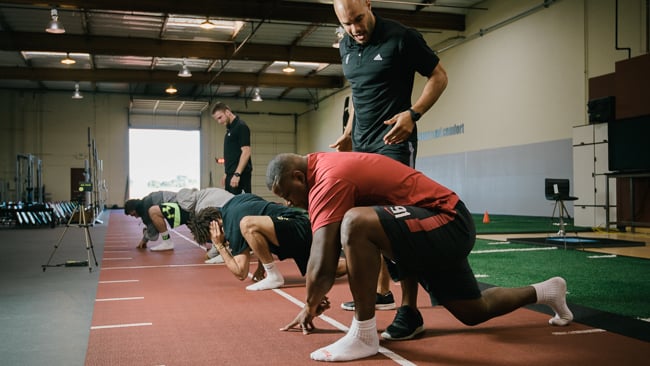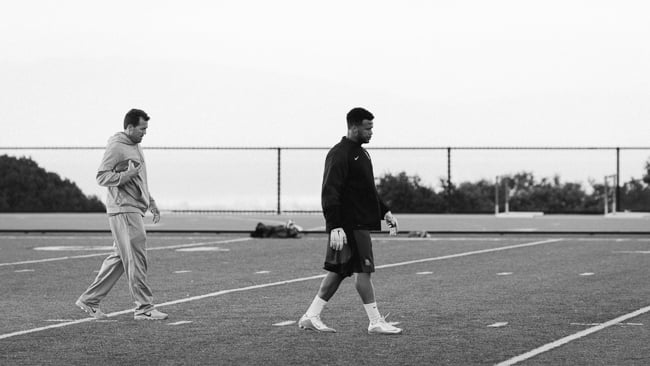
Individual sports, such as track and field, martial arts and swimming are often characterized by isolated competitions separated by weeks or months between events. A major challenge for coaches of individual sports is accurate periodization of training loads to ensure the athlete’s performance peaks at the correct time. Coaches often prescribe loading, overreaching and tapering phases before competition to meet this challenge.
Given the time between competitions and control of training loads for individual sport athletes, it is common for coaches to report an athlete’s training loads and recovery relative to the time away from competition as an indicator of how successfully an athlete is overreaching or tapering. For example, “If an athlete is 3 weeks away from race day, we will aim to perform 800 to 1000 high speed meters across 5 days of training, and the athletes should have a subjective muscle soreness score of 4 or below on a 0-10 scale at the end of the week.”
In contrast, coaches of team sports have the challenge of needing athletes to repeat an optimal performance each match/game that might occur weekly, or multiple times in a week. The team sport coaches need to repeat the optimal performance of their athletes while managing recovery, game fatigue, stress, and still allow for training to prevent deconditioning – no easy task as any coach will attest. The need to have athletes repeat optimal performances has increased the popularity of fatigue monitoring strategies in recent years.
One approach for monitoring fatigue in team sports is assessing training loads and recovery of the athletes relative to the time away from competition during the playing season (similar to individual sports). Rather than looking at a weekly time from the game coaches are forced to used days. For example, “If an athlete is 3-days away from match day, we should aim to perform no more than 400 high speed meters, and the athletes should have 4 or below for muscle soreness on a 0-10 scale.” Due to the frequency of competition, team sport athletes do not have the opportunity to go through overreaching and tapering within a few days. Investigating training load and fatigue relative to the time away from match day can lead to errors, and misjudgements in a team sport environment. There are multiple reasons for possible errors or misjudgements when interpreting results relative to their time from competition in team sports.

First, the lead-up to a match in-season for a team sport may vary between weeks. An athlete may have played 40 min during the current week, while during the previous week the athlete played 80 min. One week might have involved 2 days of travel while the other had no travel. The game day turn around may be 6 days one week and 8 days the following week. Should we expect an athlete to have the same response to training and recovery in the lead-up to these matches?
Second, team sport athletes often experience cumulative fatigue or physiological adaptation across a playing season which can change the stress response, recovery rates, and even the amount of muscle damage from equal exposure to collisions and maximal efforts. Investigating a day-by-day comparison relative to previous weeks can therefore limit to ability to identify fatigue and performance and ultimately lessen the likelihood of repeating optimal performance.
Third, collecting information and data in sport is only valuable when actionable steps can be taken from the information. Ideally, the approach to monitoring training loads should be proactive, rather than reactive. For example, if an athlete is 20% over the training load threshold at day 3 from match, do we perform 20% below on the following day or is it too late to take effective steps?
A key component of fatigue and injury risk is the relationship between acute workload (typically 7 days) and chronic workload (typically 28 days). Specifically, has the chronic exposure to training provided enough adaptation to withstand the acute workload? The workload that is investigated may vary depending on the demands of the sport. Baseball might investigate the sum of pitches thrown (7 days vs 28 days) while rugby union might investigate total distance covered via GPS analysis (7 days vs 28 days). Monitoring the imbalance between acute and chronic workloads is typically done using the training stress balance calculation:
TSB = {((7 day workload) x 4) / (28 day workload)} x 100
If the acute workload was less than the average of the chronic workload, the training stress balance would be less than 100 and be considered a negative training stress balance.
For example: 7 day total distance = 14050m, 28 day total distance = 65,080m
TSB = {((14050 m) x 4) / (65,080 m)} x 100 TSB = 86% (a negative training stress balance)
The acute vs chronic training load relationship was first described in cricket – High chronic exposure to workloads for bowlers were protective against injury while large increases to the acute workload caused an increased likelihood of injury. Furthermore, it was reported that 63% of injuries for bowlers occurred in the week following a negative training stress balance, suggesting that periods of low training volume have a large impact on injury risk.
It is common to jump to the conclusion that an athlete’s injury or fatigue was caused by a high training volume without taking into consideration the imbalance between the acute and chronic workload. Tracking training stress balance allows a coach to proactively adjust the weekly training volume relative to the athlete’s chronic training exposure, maximizing the chance of optimal performance and minimizing the likelihood of injury.
– Tim Whitehouse